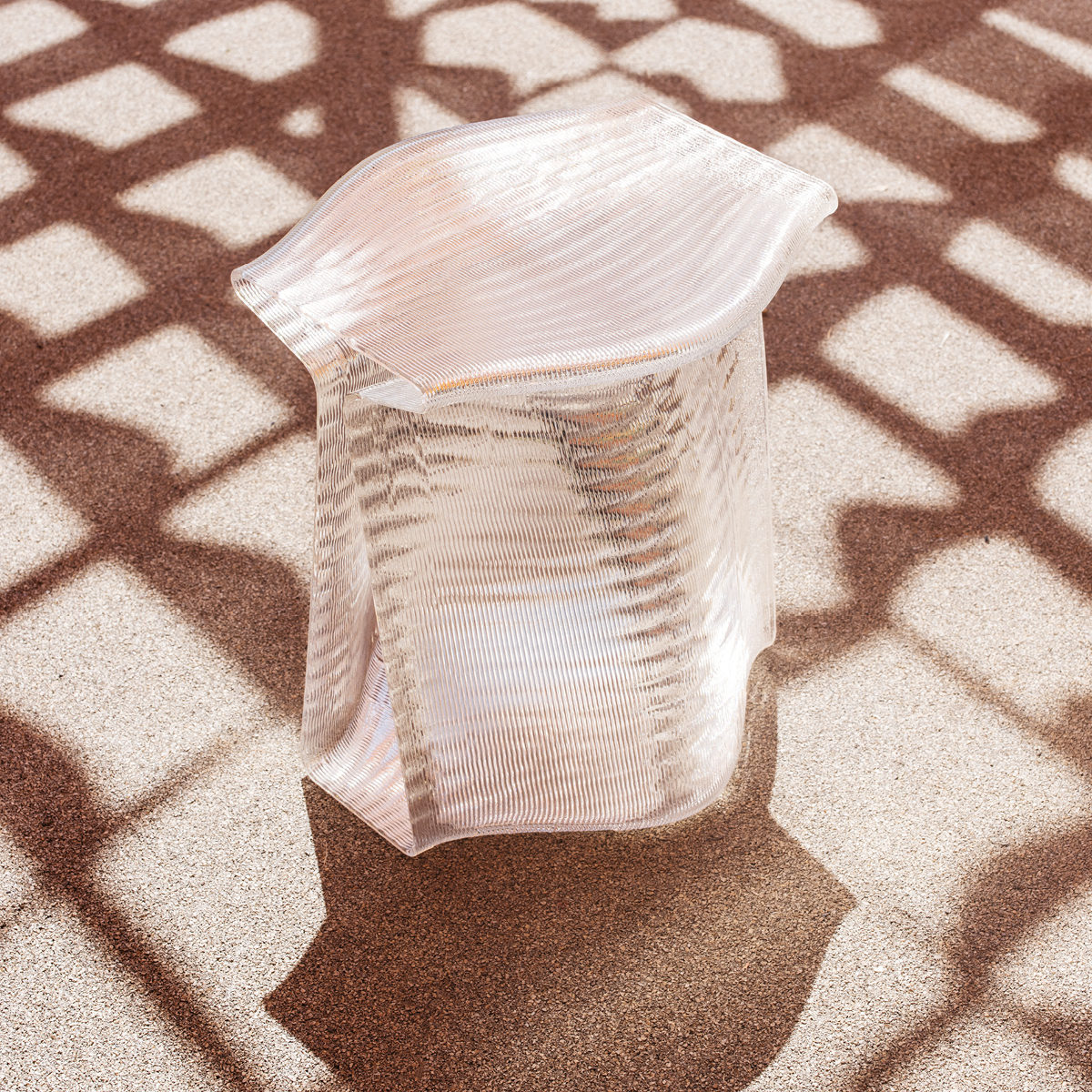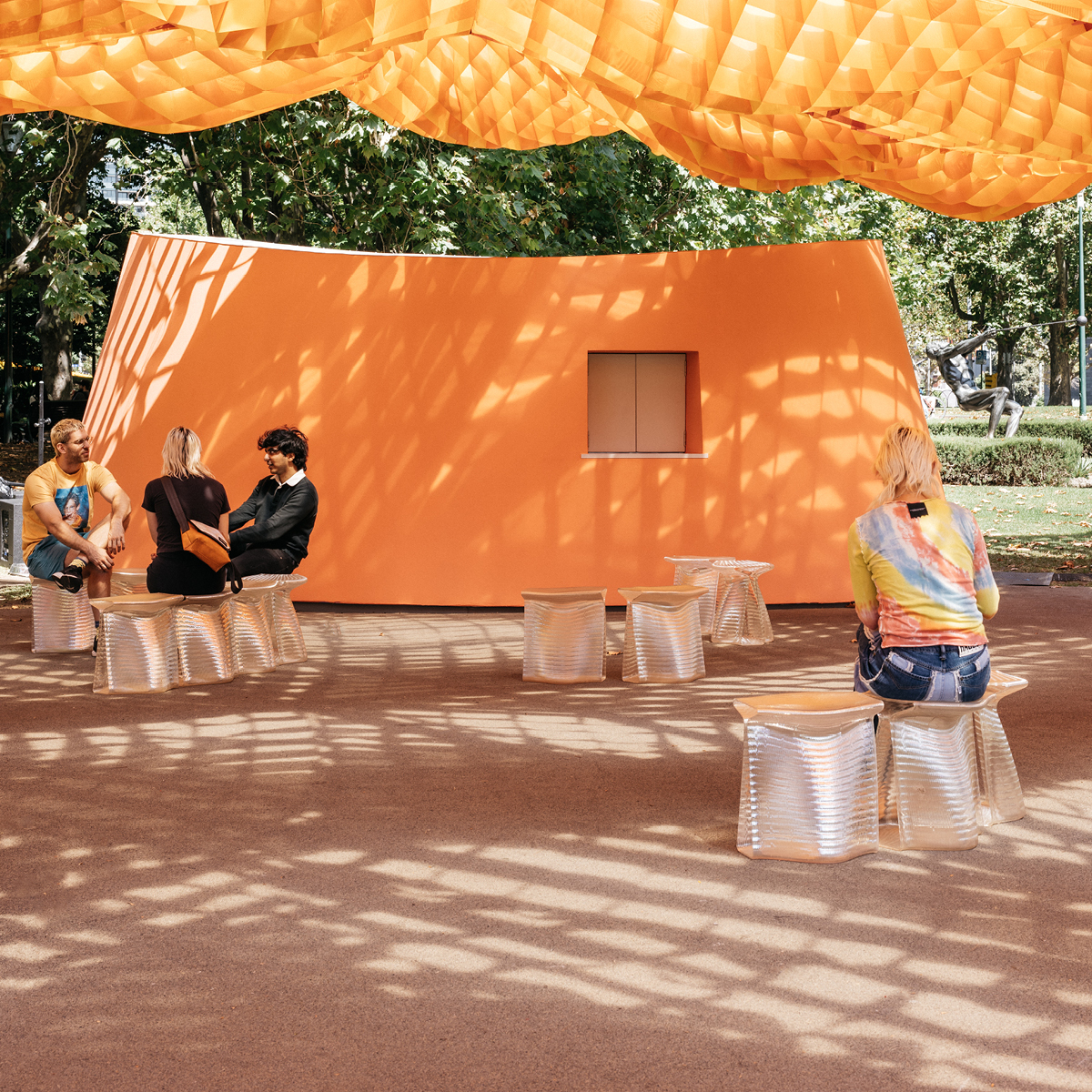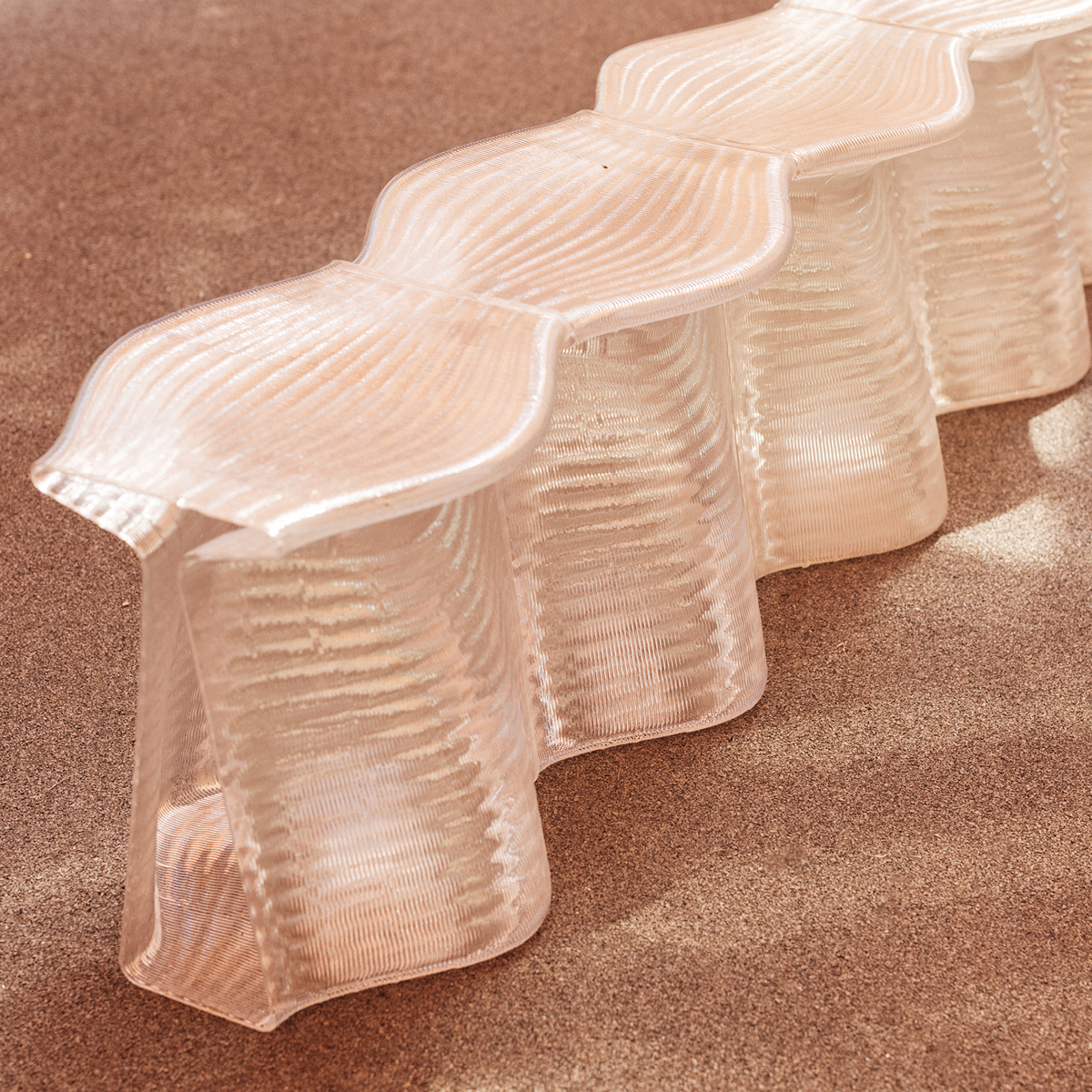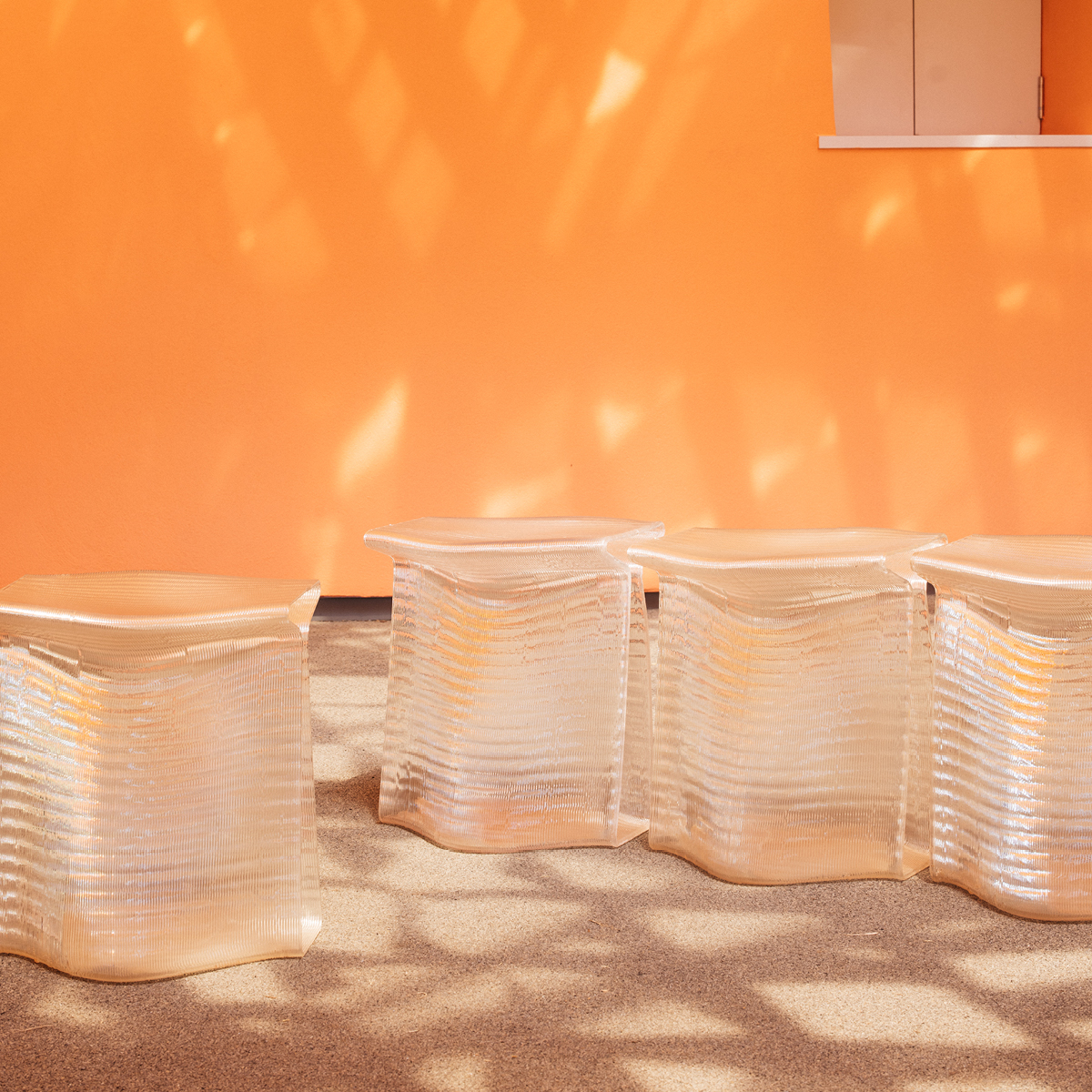“Physical prototyping plays a big role here to tune the design. There’s also a lot of calibration around the actual printing phase—how fast the robot is moving and also how fast the plastic granules are being fed. But ultimately, once we have sorted all this out, we simply generate the final code, plug it into the robot and press go!”
Sam Tomkins, Iain [Max] Maxwell and Ben Ennis-Butler are design researchers from the University of Canberra. Separately, Sam has his own studio, Tomkins Design; Max is the founding director of internationally-awarded design practice supermanoeuvre; and Ben specialises in researching new ways for people to interact with the digital collections of museums and galleries. Together, they are the core members of Canberra Design Lab.
They’re architects, industrial designers and visual communicators whose individual careers have taken them from Melbourne Design Week to the Venice Biennale. But at the university, they’re also educators, working together to bridge the professional and academic worlds. It’s an opportunity that gives them the chance to pose radical questions and envision and design objects to respond to those questions—and hopefully, get closer to an answer.
Last year as we approached the opening of MPavilion 2022, we checked in to Canberra during the midst of production to hear more about their design and take a peek into the process behind the now much-loved MPavilion 2022 ‘Re-pete’ Chair.

MPavilion: What excited you about the brief for the MPavilion 2022 chair? Did you have the idea for ‘Re-pete’ as soon as you read it, or was there an ‘ah-ha’ moment down the track?
CDL: A lot of our current research is centred around developing the robotic 3D printing techniques that we are using for ‘Re-pete’, so that’s where our focus was. We were still quite early in our explorations of what some of those 3D printing strategies can do.
We always work intensively with prototyping towards essentially one-off designs, but we’ve never had the opportunity to say, “Okay, the design is finalised, now let’s make 40 of them,”—so that was one aspect of the brief that was really exciting for us. The other was that we are big fans of all(zone)’s work and their design for this year’s MPavilion.
MP: Most people think of hands-off automation when they see the words ‘ robotic 3D printing’, but it sounds like this isn’t the case with your process, is that safe to say?
CDL: I think it depends on your sensibilities as a designer. The one consistent thing in all of our work is that technology is a lens to explore and advance design. Whether it’s the design modelling or the automation of production code and processes, we don’t do any of this in the service of efficiency. We’re doing it to try and create expressive objects.
Like here, we’re playing with very volatile material. When it’s hot and gooey, it’s kind of dripping and viscous, and as it cools, the tension in the material pulls it back to where it wants to be. You’re dealing with a gooey thing that has many opportunities to do things you don’t expect. Playing with that volatility is really exciting as well because, in a lot of designs, the material is forced to do what we as designers want it to do—there’s no agency of the material in the object, whereas we like to invite that danger.
MP: How much trial and error went into the first chair?
The first prototype was pretty much successful. The ones in Melbourne [for Craft Victoria’s ‘The Chair’ exhibition] were the fifth or sixth ones because we tried to finetune the thickness to get more compliance, flexibility, or stiffness. But there was also this challenge of producing 40 objects. We had to develop a new heated bed arrangement because we knew that we needed the changeover to be quick to meet the deadline. Like a triathlon—you lose a lot of time in transition. At an industry level, they can make a mould and punch out 10,000 or 10 million of the same object. At this micro factory scale, you need some of these efficiencies, but what does that mean and how? You’ve got to be creative and do lots of experimentation.

MPavilion: The 23rd ‘Re-pete’ chair is printing behind you as we speak. Can you talk us through the process from concept to completion?
CDL: It takes two hours, and 49 minutes to print a full-scale chair. There are four distinct phases: there’s the tool-making, the generative design, the automated generation of instruction code for the robot, and then there’s the actual robotic plastic printing itself…
We have a fairly small robot—it’s really designed to assist people in doing things, it’s not an industrial robot. We had a few challenges around that, like how do we make this little robot handle bigger information tasks like 3D printing? Like all robots, it also doesn’t come with any hands, so we needed to design and develop one: the tooling on the end of the robot.
On the design side, we do a lot of digital modelling! We use some pretty sophisticated parametric design software and spend an awful lot of time refining the chair’s shape to provide stiffness and suspension. Next, we generate and send the motion instruction code to the robot using custom code. This tool path is essentially a spiralling path of waypoints. This stage is very important because the distribution of these waypoints, where we’re telling the robot to go, has a direct relationship to the aesthetics of the chair. It creates a grain that runs through the chair, which plays with and catches the light. As such, we also spend a lot of time fine-tuning and redistributing this grain.
Physical prototyping plays a big role here to tune the design. There’s also a lot of calibration around the actual printing phase as well. How fast the robot is moving and also how fast the plastic granules are being fed. But ultimately, once we have sorted all this out, we simply generate the final code, plug it into the robot and press go!

MP: How often do you have to feed the robot?
CDL: Well, at first, it was every 10 minutes, and if you missed that 10-minute window, the extruder would come to a stop while the robot continued, and the print would fail. It definitely was a dance between us and the robot: every 10 minutes, you’d have to feed it. Now we do it about every 45 minutes to an hour.
MP: Is the robot affectionately known as anything? Does it have a name?
CDL: It’s affectionately known as Uri. Oozee’s the name of the hand.
MP: How many recycled bottles does it take to make one chair?
CDL: About 220 bottles per chair. We picked PET as our material because it’s fantastic for 3D printing and it’s relatively abundant as a recyclate, though problematic because of our current recycling infrastructure in Australia.
But while we wait for recycling infrastructure to catch up, we want to try out a different model of how a material can be recycled—where if you own the means of production, as a product maker or designer, then you can take them back at the end of their life cycle, and you can reconfigure them into something else.
And that’s really what this project is about: exploring objects as functional reservoirs of material. That’s pretty radical for designers, especially for architects who are taught to make buildings that last forever because that’s the most sustainable thing they can do. But we know they don’t last forever. If you accept that objects have very indeterminate lives and consider that as a key mechanism to design, it demands a completely different approach—not designing for permanence, but designing for indeterminacy.
MPavilion: Can you tell us how all(zone)’s design informed your response? Is there a particular element of MPavilion 2022 that you were inspired by?
CDL: The technology used to produce ‘Re-pete’ lends itself to a volumetric transparent form, which was a very natural marriage between the light-transmissive nature of all(zone)’s MPavilion and the ‘cellular roof structure’ that they’ve designed. So, it was actually quite a straightforward response, we weren’t trying to bend our own process out of shape to try and relate to their fantastic design.
Also, when we were looking at all(zone)’s design, we realised that because they use different materials, they can create different qualities of light, colour and experiences. That’s something we definitely jumped on when we were looking at their work and tried to tap into that through the changing shape and texture of our design. Plastic chairs are one of the most ubiquitous objects that we have around us every day, but I think it’s really exciting that when you change your process, the object topology radically shifts. I mean, this is a plastic chair, and doesn’t really look like any plastic chair that preceded it, which we think is quite interesting!
MP: If you could see ‘Re-pete’ be remade into anything after the season, what would you want it to be?
CDL: We’ve been really interested in products that see a very high turnover because they sit within this idea that you kind of “rent” the product. It doesn’t have to be the Rolls Royce, it can just be the bookcase behind you, or coffee tables.
The chair is still in Melbourne, but then who knows? It could find its way into a bank or into Parliament House!







